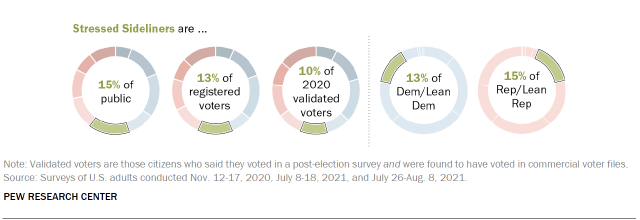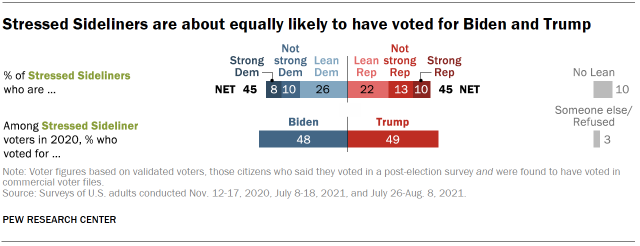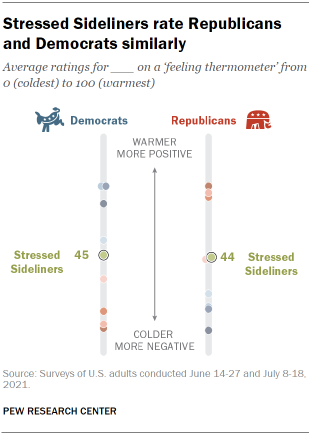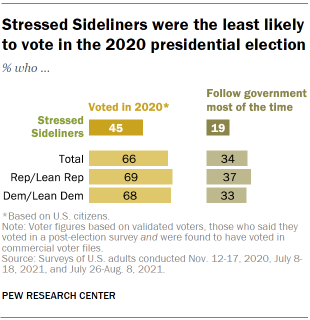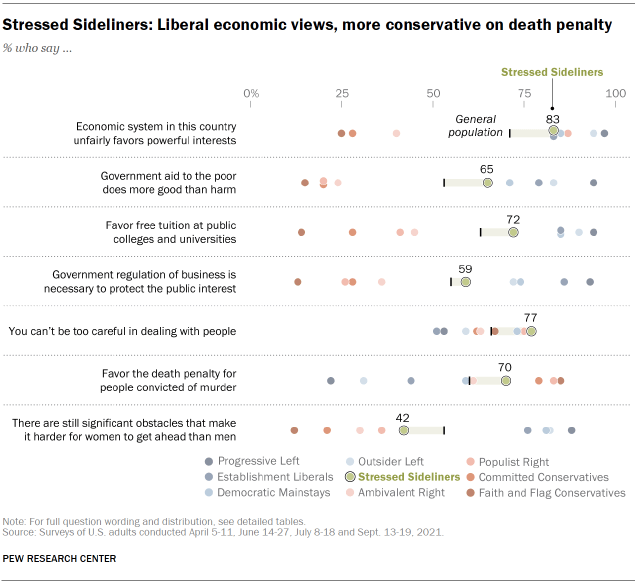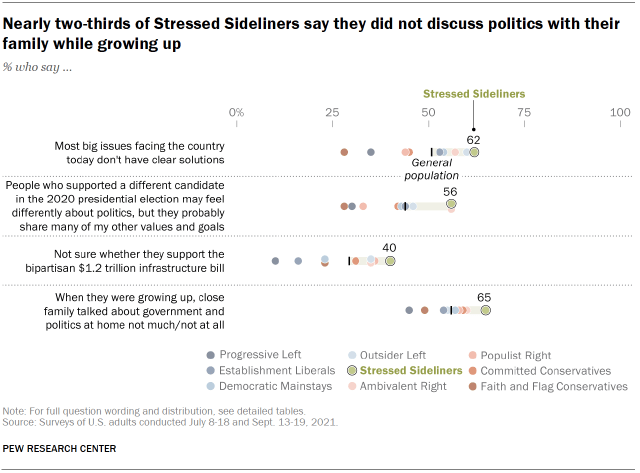Mixed political views, low interest in politics
Stressed Sideliners are generally disconnected from politics and the two major parties, voting at lower rates than most other typology groups. Although Stressed Sideliners make up 15% of American adults, they were just 10% of 2020 voters due to their relatively low turnout rate. Still, they represent substantial shares of both parties’ coalitions.
Stressed Sideliners are split evenly between those who identify with or lean toward the Republican Party (45%) and those who are Democrats or Democratic leaners (an identical 45%). One-in-ten say they don’t lean toward either party. While they tend to fall close to the average American on many issues, they lean liberal on economic issues and tilt conservative on some social issues.
A large majority (83%) say the economic system in this country unfairly favors the powerful, and about three-quarters (74%) favor raising the minimum wage to $15 per hour. Roughly a third of Stressed Sideliners (35%) say that same-sex marriage being legal in the United States is bad for society, compared with 26% who say this is good (39% say it is neither good nor bad for society).
About four-in-ten Stressed Sideliners (43%) live in lower-income households, higher than most other political typology groups. And they are the group most likely to describe their personal financial situation as only fair or poor (63% say this). Stressed Sideliners are also one of the least highly educated groups.
Political affiliation, voting and engagement
About two-in-ten Stressed Sideliners consider themselves Republican (23%), while a similar share identify as Democrats (19%), but a majority say they are either independent (34%) or identify as “something else” (20%). Taking both party identification and partisan leaning into account, they are evenly split (at 45% each) between the two major parties.
This group also rates the parties similarly on a 0 to 100 “feeling thermometer.” Stressed Sideliners give Democrats an average rating of 45 – slightly cooler than the midpoint of 50 – and they give Republicans a nearly identical average rating of 44.
Stressed Sideliners who voted in the 2020 presidential election were about equally likely to choose Donald Trump (49%) or Joe Biden (48%). About four-in-ten (39%) say they approve of the job Biden is doing as president as of a September survey, higher than the share in any of the four Republican-oriented groups but lower than the share in any of the four Democratic-oriented groups.
Fewer than half (45%) of Stressed Sideliners who are adult citizens voted in the 2020 presidential election. This turnout rate was 10 percentage points lower than the next lowest group (Ambivalent Right, at 55%) and 21 points lower than among all adult citizens. Few in this group express much interest in politics more generally: Just 19% say they follow what’s going on in government and public affairs most of the time.
Stressed Sideliners: Key political attitudes and beliefs
Stressed Sideliners fall in between the Republican and Democratic coalitions in many of their key attitudes about government. For instance, about six-in-ten (59%) say that government regulation of business is necessary to protect the public interest, similar to the 55% of all adults who say this.
On economic issues, this group generally leans liberal. About seven-in-ten (72%) favor making tuition at public colleges and universities free to all American students. Majorities also say that the federal government has the responsibility to provide all Americans health insurance (74%) and an adequate standard of living (64%).
Stressed Sideliners are somewhat more conservative on some social issues. Seven-in-ten favor the death penalty for people convicted of murder. And Stressed Sideliners are 11 percentage points less likely than adults overall to say that there are still significant obstacles that make it harder for women to get ahead than men.
They also express lower levels of social trust than average: About three-quarters (77%) say “you can’t be too careful dealing with people,” compared with 66% of the general public.
Low political engagement
Nearly two-thirds of Stressed Sideliners (65%) say that, when they were growing up, close family did not talk about government and politics at home much or at all. Those in this group are also more likely to express lower levels of political interest and are less certain about their political views today.
Roughly six-in-ten Stressed Sideliners (62%) say that most big issues facing the country today don’t have clear solutions, a higher share than those who say this in any of the three most Republican or the three most Democratic groups.
About a quarter (24%) of Stressed Sideliners who are registered to vote say they aren’t sure who they would vote for if the 2022 elections for the U.S. House of Representatives were held today, slightly higher than the share of registered Ambivalent Right who say this (19%) and higher than the share in any other group. Four-in-ten also didn’t have an opinion about the $1.2 trillion bipartisan infrastructure bill under consideration in Congress, a September survey found.
This group exhibits less partisan animosity than other typology groups. A majority (56%) say that, while people who supported a different candidate in the 2020 presidential election may feel differently about politics, they probably share many of the same values and goals. Only one other group, Ambivalent Right, contains a majority who say this; in all other groups, at least half say that they probably don’t share many other values and goals with those who supported a different presidential candidate.
Stressed Sideliners: Who they are
A majority of Stressed Sideliners (56%) are women. Roughly six-in-ten (57%) are White, while 21% are Hispanic, 10% are Black and 5% are Asian. They generally look similar to U.S. adults overall in terms of age: 18% are under the age of 30, 34% are between 30 and 49, 31% are 50 to 64, and 17% are 65 and older. Stressed Sideliners’ religious affiliation and practices largely parallel the population as a whole.
Stressed Sideliners have less formal educational experience and lower household incomes than other groups. Nearly half (48%) have only a high school diploma or less education, while 29% have some college experience but no degree and 22% have a college degree. About one-in-four (43%) live in lower-income households, with just 10% living in upper-income households. And Stressed Sideliners are the most likely of any group to say they don’t have a savings account; a third of this group says this.
